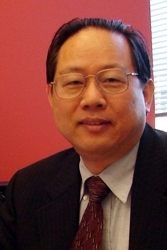ODU's Lee Publishes New Bioenergetics Hypothesis
August 27, 2012

A hypothesis published this summer by James Weifu Lee, a faculty member in the Department of Chemistry and Biochemistry at Old Dominion University, posits answers to some nagging questions in an area of study known as bioenergetics, and could help us to understand how life began on Earth.
For the layman, the article presents interesting background on the role of electrochemical energy in supporting life. This concept was being discussed even in the 19th century when Mary Shelley borrowed from the science of her era to imagine how electricity could bring Frankenstein's monster to life.
Bioenergetics is the study of energy transformations within and between living things and their environments (for example, as in photosynthesis). Almost all cells gain energy by pumping protons - hydrogen ions - across their membranes. The protons are pumped over tiny protein turbines in the membrane, creating the energy needed to synthesize ATP, a nucleoside triphosphate that serves as an energy reservoir. As it is disassembled, ATP can discharge energy to power various cell functions such as reproduction (cell division).
Only a half century ago, British scientist Peter Mitchell proposed the conceptual scheme that identified the role of proton coupling in the formation of ATP in cells. Mitchell's proton gradient, known as the "proton motive force," was initially quite controversial. But it would win for him the Nobel Prize in Chemistry in 1978.
Questions about Mitchell's hypothesis - which he labeled as "chemiosmotic" - have never gone away, however, and Lee said he has been intrigued for many years by research that indicated the full extent of Mitchell's idea didn't always hold up in experiments. Twenty years ago in a physics class he was taking at Cornell University, Lee began to develop what he calls his "proton-electrostatics hypothesis for localized proton coupling bioenergetics" to address the experimental discrepancies with Mitchell's chemiosmotic concept.
His article laying out the hypothesis was published in July by the online journal Bioenergetics.
Mitchell conceived proton coupling as a delocalized function of electrochemical-potential gradients across the membrane. "Delocalized" here means that the protons are evenly dispersed like solute molecules in the bulk aqueous phase of a cellular or sub-cellular compartment, such as in the lumen water phase of a chloroplast. .
For Lee, the operative terms are "localized" proton coupling involving "electrostatics" at the "water-membrane interface", which, according to Lee's hypothesis, may contribute to the proton motive force.
The movement of localized subatomic particles is restricted by the electrostatic protons conduction and mutual repulsion effect. Electrostatics involves the same static electricity that shocks us when we touch a doorknob after walking across a carpet; an excess of electric charge is trapped on the surface of an object until it has a chance to escape to an object with a weaker or opposite electrical charge. Tiny amounts of water inside cells act as efficient proton conductors in Lee's hypothesis.
"Mitchell's chemiosmotic theory is a cornerstone of bioenergetics," Lee writes in the journal article. "However, the Mitchellian view of a single delocalized-proton coupling mechanism to drive the synthesis of ATP seems not to be entirely correct.
"According to the proton-electrostatics localization hypothesis, protons injected into a thylakoid may, owing to their mutual repulsion, be quickly localized electrostatically at the water-membrance interface along the lumenal surface of the thylakoid membrane for energetic coupling in a fast-acting, dynamic manner."
(The thylakoid in plant cells is a membrane-bound compartment that contains another compartment called the lumen. These cell components are the site of the reactions of photosynthesis.)
Lee said the model he offers "indicates that the Mitchellian view could be true only in special cases when the trans-membrane potential difference is near zero and the bulk pH difference becomes the dominant driving force" for ATP synthesis. "The proton-coupling under most physiological conditions for photosynthesis is likely to occur in a mixed mode of both electrostatic proton localization at the membrane surface and proton delocalization within the bulk phase."
"With the electrostatic proton localization model, you can also see the beauty of the bioenergetics systems that resulted from billion years of evolution and natural selection," Lee said. "For example, in a chloroplast system, as protons are photosynthetically released at the lumenal surface, they can be quickly distributed along the lumenal water-membrane interface because the water body in the lumen is essentially a proton conductor."
Consequently, photophosphorylation through the tiny protein turbines for ATP synthesis could begin immediately with electrostatically localized protons, before proton distribution into the bulk phase occurs. Such a proton coupling energy transduction mechanism enables the swift and efficient use of sunlight energy in photosynthesis beneficial to survival.
Although he focuses on plant cells, Lee said his hypothesis leads to a new bioenergetics equation for the proton motive force that may "provide a unified framework for understanding the energetic of many biological systems."
He added that the hypothesis "is based on proton electrostatic conduction and localization in a biologically relevant water body, which may also have fundamental bioenergetics implications in understanding the importance of water in the formation of life on Earth and beyond."
Some scientists have speculated that conditions for the creation of living cells would have been present four billion years ago where hydrothermal vents on the ocean's bottom shot out alkaline water. Differences in temperature and pH between the vent water and the seawater, plus the vent's steady supply of hydrogen gas, carbon dioxide and inorganic micropores similar to cells, could have supplied the proton gradient and materials necessary to create the first living cells.

